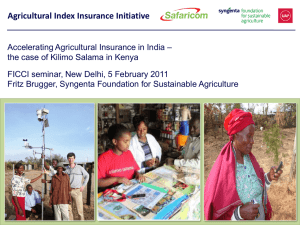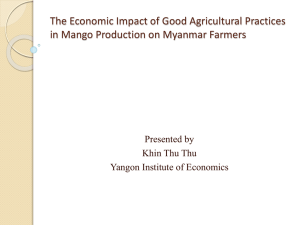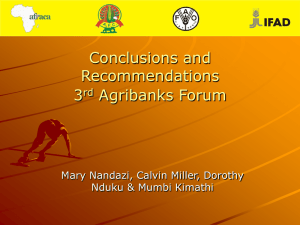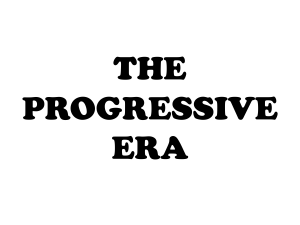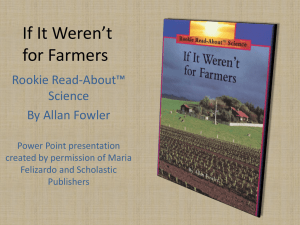Farmers Access to Climate and Weather Information and its Impact
advertisement
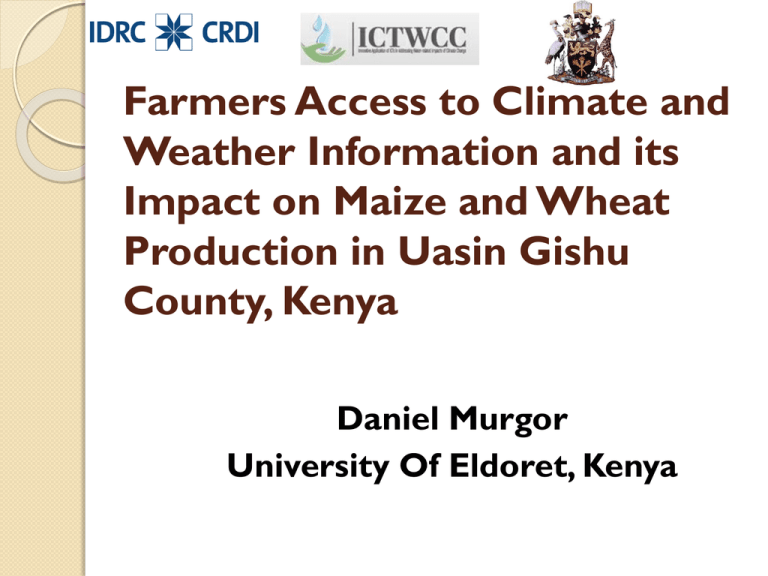
Farmers Access to Climate and Weather Information and its Impact on Maize and Wheat Production in Uasin Gishu County, Kenya Daniel Murgor University Of Eldoret, Kenya Introduction High climate variability in farming environments depresses crop productivity and constrains investment in agricultural sector. In most sub-Saharan Africa countries Kenya included, ensuring household food security in rain fed agricultural livelihood system with the prevailing climatic variability requires availability of information on climate and weather that will reflect onset & cessation of seasonal rains Introduction – Weather challenges Adaptation strategies require climate information on a spatial scale that will be meaningful for planning. Poor maize crop Megun Ward, Kesses Sub County. Source: field data 2013 Weather challenges Wheat harvesting with prevailing heavy rains, Mumetet Ward, Moiben Source: Field data 2013 Farmers Calendar JAN FEB MAR APR JUN SEPT OCT SEPT Problem Statement The prevailing climatic variability has distorted completely timing of seasons familiar to farmers dealing with maize and wheat Farmers rendered vulnerable and have incurred losses in their farming enterprise Good quality climatic and agronomic data and time series of climate information is not readily available to farmers & planners in most developing countries Kenya included. Problem Statement In Uasin Gishu County, climate & weather information is not readily coordinated, shared or disseminated in a timely way. There is also a major challenge of adaptability, format and timing challenges of climate information. ----The information is not downscaled and repackaged in formats that farmers access, understand and can use. Objectives To determine the types and sources of information on climate and weather accessible to maize and wheat farmers in Uasin Gishu County. To examine the modes of communicating information on climate and weather to farmers. To determine the perception of farmers towards the use of information on climate and weather and the influence of their traditional knowledge system in maize and wheat production;. To examine the influence of information on climate and weather in maize and wheat production. To determine acceptability of use of mobile phone technology to relay climate and weather information to farmers in the community. To develop model to relay climate information to maize and wheat farmers in Uasin Gishu County. Methodology The study conducted in Uasin Gishu County in three sub-county areas of Moiben, Kesses and Soy selected purposively for exhibiting maize and wheat growing. The cross sectional study adopting a mix of purposive, stratified and random sampling procedure selected 399 farmers for the interview & 12 key informants The questionnaire was developed in line with the conceptual framework. Methodology For populations that are finite, Reid & Bore (1991) developed the equation for representative sample; = 399 Thus, Soy= 1138/129384) *399 =189 Moiben = (38950/129384)*399= 120 Kesses = (29296/129384) *399= 90 Theoretical Framework This study is guided by three theories: the systems theory by Ludwig Von Bertalanffy 1968 The communication model also referred to as the transmission model by Shannon and Weaver 1949 and Vulnerability adaptation framework (Ospina & Heeks, 2010). Conceptual Framework Climatic variability has distorted completely the timing of seasons familiar to farmers through experience Indigenous knowledge systems + experience gained + climate and weather information = beneficial outcome as illustrated in the framework framework.docx Key results- Perception on climate variability – rainfall changes 100 90 80 70 60 %50 40 51.2 36.7 30 20 10.6 10 1.6 0 Strongly agree Agree Disagree Stongly disagree Sources of climate and weather information for farmers, its access and usage There is low access to climate information 155 (40%) compared to 236(60%) who do not receive the information at all although KMD produces Farmers do not largely integrate climate and weather information in their farming decisions due to Adaptability, format and timing challenges of the information Access to Information Access to information is generally farmer led agricultural shows, farmer’s field/ demonstrations are other information outlets Sources of information for farmers 100 90 80 70 60 % 50 40 30 20 10 0 50 46.2 17.5 5.3 1.3 1.5 Inform… source Indigenous knowledge systems are other sources of information that informs a farmer’s decision in the farming calendar There is a significant relationship thus between access and usage of information (Chi = 87.263, P < 0.001). Similarly, education level is significantly related to access to climate and weather information (Chi = 17.957, P = 0.001). Influence on farmer decision 100 90 80 70 60 % 50 40 30 20 10 0 84.9 36 5.4 3.1 7.4 Influence on farmer decision Farmer’s indigenous knowledge system indicators and experience greatly influences their decision in maize and wheat growing The use of indigenous knowledge system to plan farm activities alone have made famers incur loses as they fail to capitalize fully on beneficial weather conditions prevailing then Indigenous knowledge indicators 100 90 80 70 62.7 60 % 50 40 45.5 49.9 40.7 30 20 10.7 10 0 Lightening Cloud cover flashes in and intense Tinderet sunshine Wind direction Very warm Difficulty in nights prediction recently Indigenous knowledge weather forecasting Moiben Sub-county Source: Field data, 2013 Disseminating climate information - mobile phone (SMS Alerts) While Radio and Television was cited as the most common means of receiving information on climate and weather as agreed by (79.8%) and (68.4%) farmers respectively, farmers also preferred use of mobile phone (51.4%) to receive climate updates Delivery of agro-meteorological services that include climate information is poorly coordinated and one of the challenges is the format and media used in disseminating this information to the farmers. Information Dissemination- Mobile phones Mobile phones accessible and convenient to majority of farmers as confirmed by (92.2%) Farmers also further stated that they use their mobile phones to receive text messages (SMS) as affirmed by 93.9% Almost all the farmers (96.3%) preferred to receive or get updates (SMS Alerts) on climate and weather information through the mobile phone Model to deliver climate information to farmers The model developed uses SMS alerts to update farmers on climate advisories and relevant information to support farmers on farm decisions as illustrated in diagram:- model information flow.pdf Conclusion and recommendation Famers continue to rely on Agricultural extension officers and their fellow farmers for climate and weather information thus the need to empower officers with good quality climate and weather information and training Agricultural shows, farmer’s field day/demonstrations and billboards are good outlets for climatic information to farmers and should be supported and scaled up. Conclusion and recommendation There is need to integrate both traditional knowledge systems and scientific information for synergy forecasting---Some of the principles of the predictors like wind flow, temperature changes converge with the scientific forecast Important to understand the local people’s indigenous knowledge systems and conduct effective outreach programs coupled with educational initiatives for uptake of climate information Conclusion and recommendation A strong link, including feedback loops between scientists, advisory agents and farmers is crucial for communicating climate information ---This can be enhanced by the communication model developed The developed climate information model can be supported, implemented and scaled up to include other agricultural information and propagated in other Counties of Kenya and beyond Thank you for the time THE END






